#co-mingled recycling
Explore tagged Tumblr posts
Text

Discover Richmond Waste's comprehensive approach to Industrial Waste Management, offering sustainable and efficient solutions tailored for commercial sectors. Dive into our services designed to minimize environmental impact while maximizing operational efficiency. Perfect for businesses seeking responsible waste handling and recycling strategies.
#Industrial Waste Management#skip bin hire#commercial bin service#commercial waste disposal#liquid waste services#waste management#builders waste removal#liquid waste disposal#co-mingled recycling#construction waste recycling
0 notes
Text

Waste Removal In Melbourne
We’re your go-to experts in waste removal in Melbourne, handling everything from everyday rubbish and recycling to specialised waste needs. We tailor our services to meet your needs thanks to our strong partnerships with Melbourne’s top waste collectors. We ensure a smooth and efficient process, whether green waste, plastics, or co-mingled recycling. Trust us to manage your waste with precision and care. We’ll work with you to determine your waste type and volume so that we can tailor your waste solution entirely to your needs. Contact us today to see how effortlessly we can handle your waste removal needs. Visit us at: https://www.wastesense.com.au/waste-management-melbourne/
1 note
·
View note
Text
Quick & Easy Skip Bin Hire kirrawee | Residential & Commercial
Get a full range of waste management solutions with personalised, friendly and responsive service. Skip bin hire in kirrawee provides a wide range of services, including general waste disposal and co-mingled recycling. Contact now for more.
0 notes
Text

Shredding Machine Manufacturers
The manner in which discarded materials are collected has a considerable impact on their worth. The rationale for this is that co-mingled materials have the potential to decrease material quality or necessitate further sorting before recycling, which raises operating costs. To prevent this extra cost, make sure you get your cardboard material separately.
#Shredding Machine in Chennai#Shredding Machine in Hyderabad#Electronic Waste Shredders Manufacturers in Tamil Nadu#Shredding Machine Manufacturers#Best Shredders in Chennai#Heavy Duty Shredders in Chennai#Pharma Waste Shredder Manufacturers#Cardboard Perforator Manufacturers#Waste shredders Best price in India#Buy Paper shredder Machine
0 notes
Text


how to get yourself instantly blocked
#definitely totally normal thing to say on a post about co-mingle city recycling dude#you fucking weirdo#to no one’s surprise the unabomber praiser is a transphobe and obsessed with andrew jackson and is racist#shocker…
4 notes
·
View notes
Text
Mars has been a fan of rum since his days growing up in Hawaii.
By Jonah Flicker on January 14, 2021
It seems like every celebrity has a tequila brand these days, with The Rock, LeBron James, and Nick Jonas all jumping into the world of agave spirits over the past year or two. But for multi-talented pop star Bruno Mars, it has always been about rum. After SelvaRey came onto his radar a few years back, he knew immediately he wanted to get involved with the brand and is now a co-owner and creative director helping to guide its global vision.
Up until now, SelvaRey consisted of two premium expressions—a white rum that has been aged and then charcoal filtered, and a chocolate-flavored expression. Both are single estate rums produced in Panama by master blender Don “Pancho” Francisco Fernandez. He has been a “maestro ronero” (or master rum maker) for five decades, initially in his homeland of Cuba and since the ‘90s in Panama. Fernandez oversees the entire operation, which is notable for employing sustainable practices like eschewing chemical pesticides and reducing its carbon footprint by recycling waste as fuel and fertilizer.

Flo Dechard/Courtesy SelvaRey Rum
There have been some changes to the brand recently, including an updated bottle design and the addition of the aged, ultra-premium Owner’s Reserve expression. For this brand-new release, Mars worked closely with Don Pancho, who selected 15- to 25-year-old rum to blend together into a flavorful sipping spirit. Notes of banana, brown sugar, tropical fruit, and oak mingle together on the palate, followed by a long, lingering finish. Owner’s Reserve ($149) is now available in limited quantities.
Mars talked to Departures in an exclusive interview about the new Owner’s Reserve rum, how he got into the spirits business, and what some of his favorite cocktails to make at home are.
Over the past few years, it seems like tequila has been the spirit of choice for celebrities to get involved with. Obviously, for you it was rum. Why?
I met the founders of SelvaRey about seven years ago, after I was sent their white and chocolate rums. The rums had won a bunch of awards. They tasted like tropical luxury, like being transported on a vacation. I started having the rum shipped to me regularly, and over time built a great relationship with Seth [Gold] and the founders. I knew they had something special so I came on board to bring whatever magic I could to help build this world. But really, the best thing about this is that you can take me out of the equation and the rums are still award winners.
What was your experience and familiarity with rum back when you started the brand? How much did you know about the category and were you always a rum drinker?
Growing up in Hawaii, rum was what I was most familiar with—mai tais, rum punch, mojitos, piña coladas. I’ve had phases of getting into different cocktails and spirits, but rum has always been my go-to.
Was launching an ultra-premium expression like Owner's Reserve part of the plan from the beginning? Were you personally involved in selecting the rum that would go into the blend?
Honestly, it wasn’t part of the original plan, but I was very involved. It was something I wanted us to develop because dark, aged rums are my favorite. I knew what I wanted. It had to be not just the best, it had to blow other rums out of the water. Thankfully, our distiller in Panama is a genius. I asked Don Pancho if he could make something like that for us. We went through a bunch of versions and landed on the Owner’s Reserve. It’s the greatest rum I ever tasted. It needed to be something that would impress the biggest rum or even whiskey and tequila experts. But at the end of the day it just had to taste delicious. And it does.
In your opinion, what are the characteristics of high-quality rum?

Flo Dechard/Courtesy SelvaRey Rum
To me, the beauty about being in the spirits category is that it’s very yes or no. It either tastes good or it doesn’t.
How did your relationship with Don ‘Pancho’ Francisco Fernandez come about? Were you familiar with him as a rum maker before you started working together?
My relationship with him came from meeting the partners at SelvaRey, who had worked with him to develop the white and chocolate rums. They told me who he was. His story is incredible. He’s the real deal.
What are some of your favorite rum cocktails to make at home?
Rum and ginger ale is the easiest way to get the party started. When I want to show off, I make a mean piña colada. And when I’m hosting serious VIPs, they get treated to a mango colada, but only in mango season… obviously.
What are your hopes for 2021, both personally and for the growth of SelvaRey?
I hope non-rum drinkers are ready to jump on this rocketship with me. And to the rum drinkers out there, ask yourself, why would you buy rum from a pirate when you can buy it from a player? Insert sassy sparkle emojis.
6 notes
·
View notes
Photo
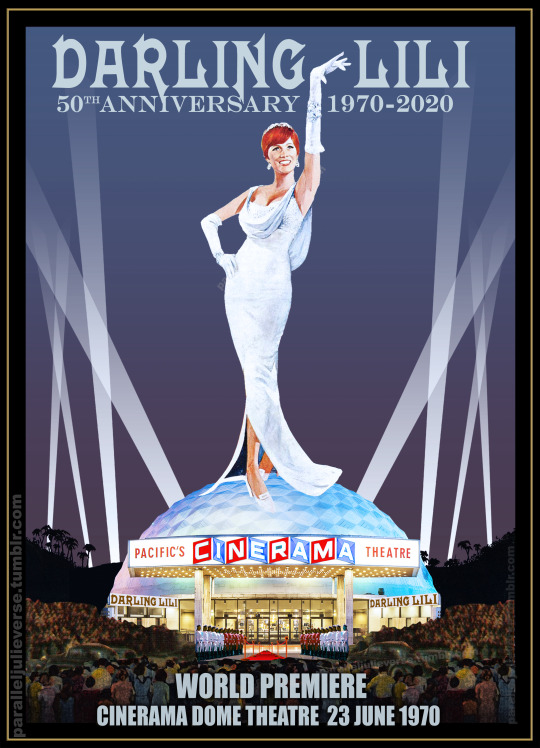
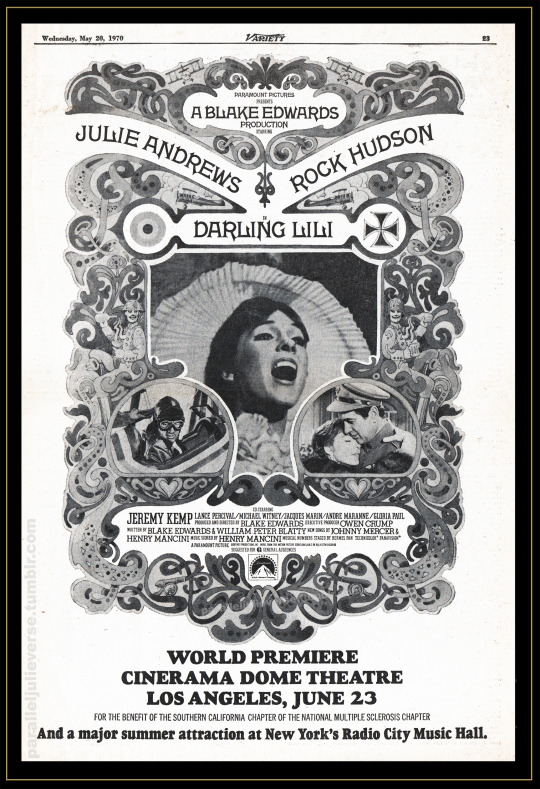
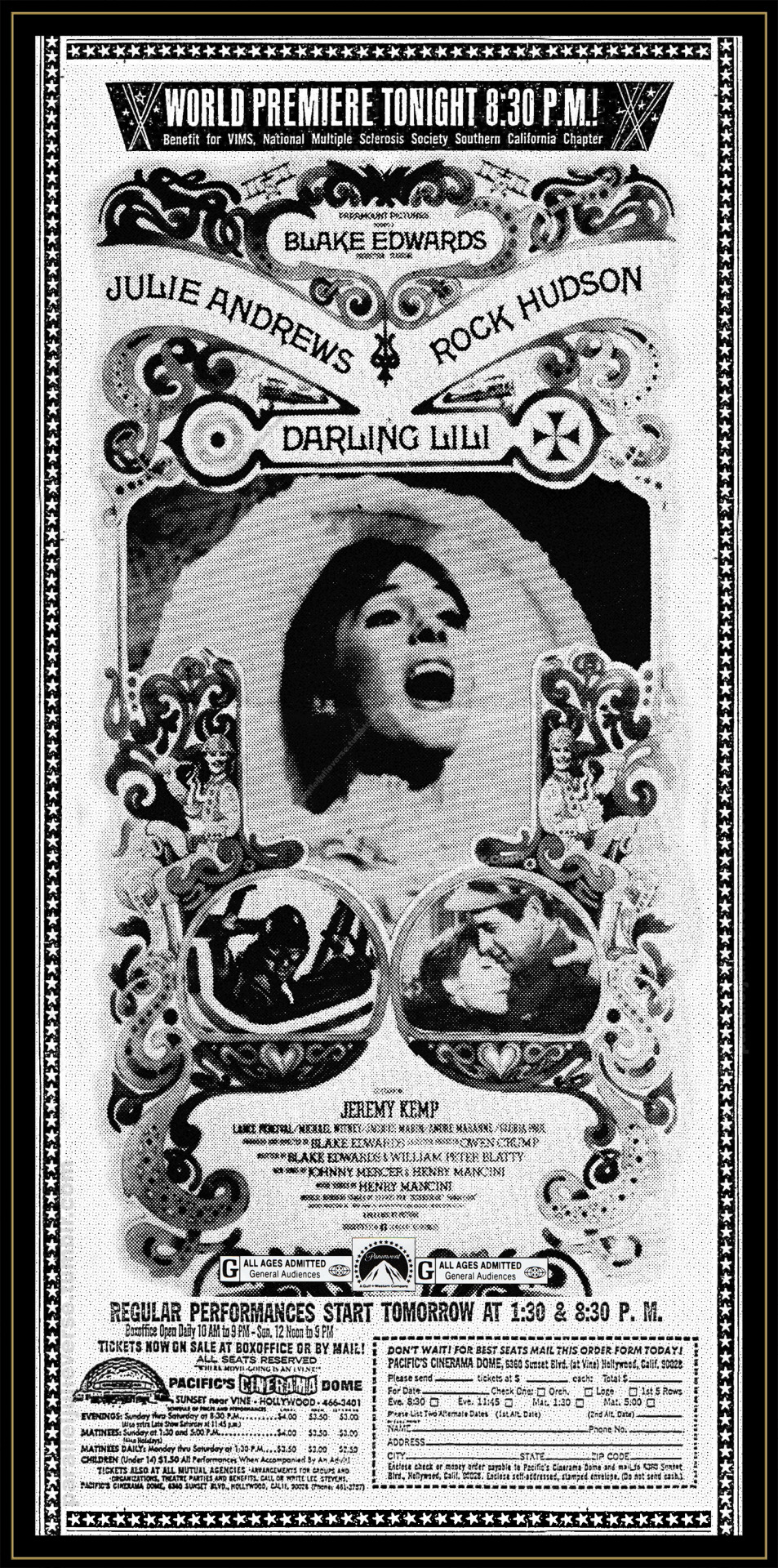
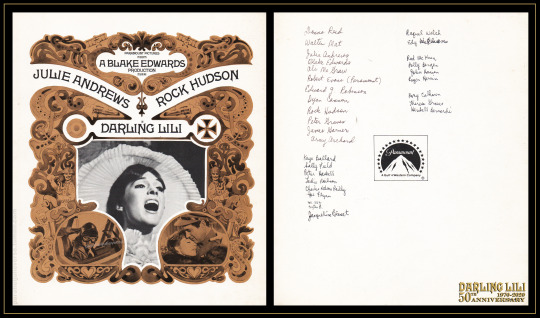

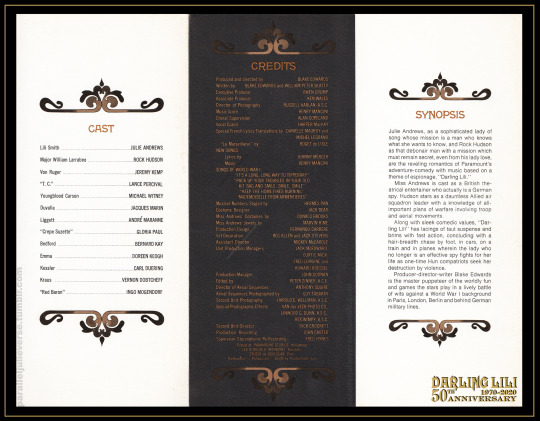
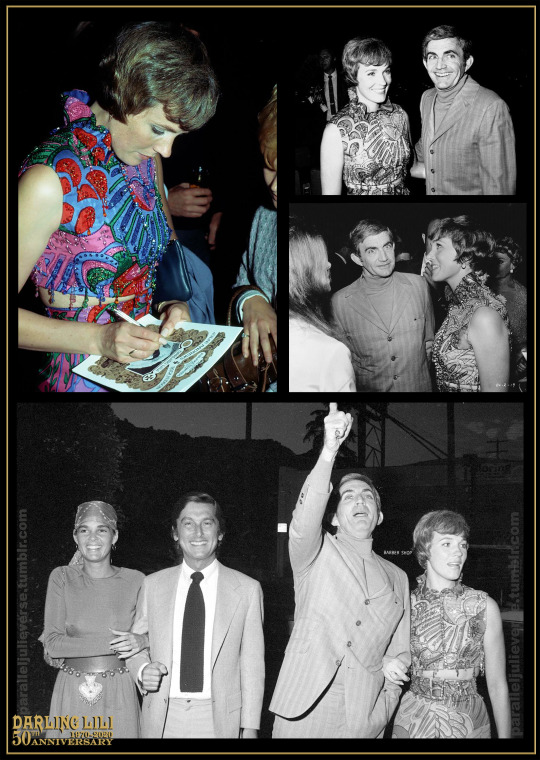
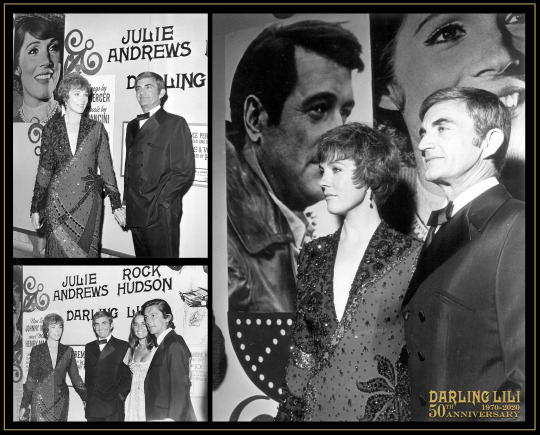
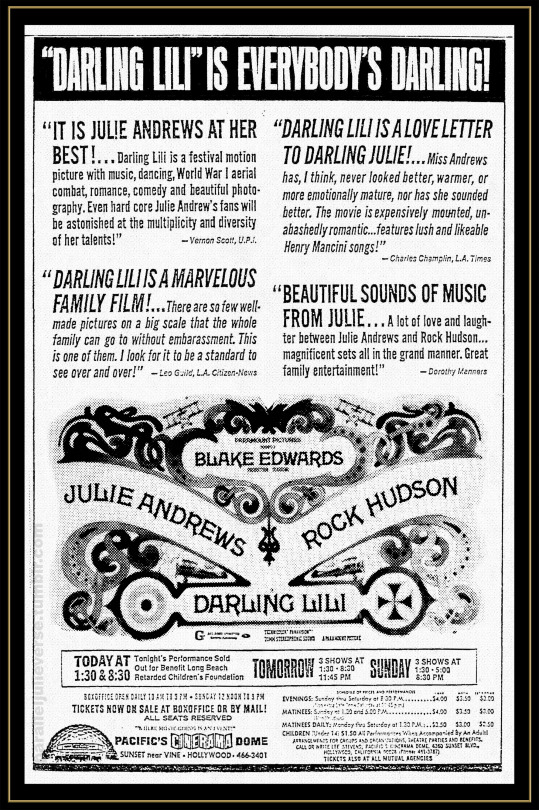
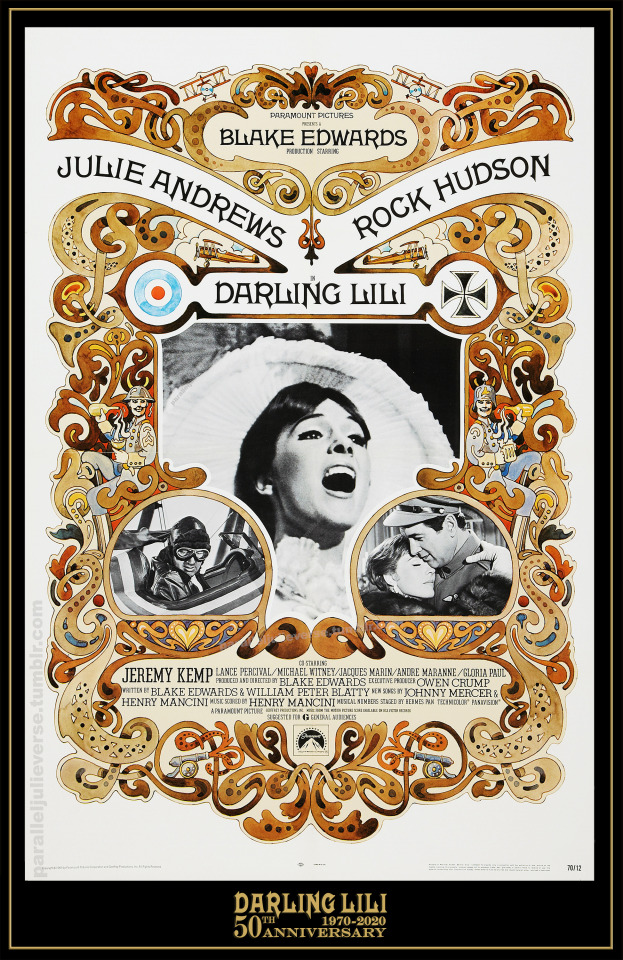
An Angel from Heaven Come to See Us: Darling Lili Turns 50
This week fifty years ago, Darling Lili -- the last of the big Julie Andrews screen musicals of the 1960s -- had its long-delayed World Premiere at Hollywood’s Cinerama Dome on 23 June 1970.
The event marked the symbolic endpoint of a three-plus-year marathon in which the ill-fated production was beset by an endless stream of problems and delays from inclement weather and union pickets on location to studio takeovers and shady refinancing deals (Bart, 63-72; Dick, 146-48; Wasson, 146-48). This litany of setbacks saw the film’s already sizeable budget blowout to era-record levels estimated anywhere, depending on who you spoke to, between $14-25mill. (Warga, C-20; Wedman, 7-A; Kennedy, 175-77). Egos clashed, tempers frayed and recriminations flew with writer-director, Blake Edwards, blaming Paramount Pictures for imposing impossible demands, and studio executives firing back counter-accusations of reckless indulgence and profligacy (Oldham, 24-25; 44-45).
That this highly publicised drama played out against the backdrop of the greatest economic downturn to hit Hollywood in half a century garnered Darling Lili an unenviable advance reputation as “the archetypal flop among big budget Hollywood productions” (Oldham, 44). “Rarely has so much bad word of mouth preceded a picture,” wrote the Saturday Review, “As the shooting schedule increased, as the costs mounted, everyone was certain that Darling Lili would prove to be a landmark disaster” (Knight 22). Another widely syndicated newspaper article dubbed it, “The Most Maligned Movie Ever,” prompting Blake Edwards to fume: “I’ve never known of an important picture in production so talked about, whispered about, and, yes, lied about as Darling Lili” (Manners, B5).
Adding fuel to widespread perceptions of the film as a legendary bomb in the making, the release of Darling Lili was held up for over a year by nervous studio execs. By 1969, Paramount had more big budget roadshow product in the pipelines than any other Hollywood studio (“Par’s Big”, 3). Panicked by the repeated failure of roadshow releases, in general, and the growing cultural backlash against big budgeted musicals, in particular, the studio feared they were “on the verge of an unprecedented financial disaster” and vacillated over how to proceed (Farber, 3). They ordered competing rounds of edits to the film, taking material out to secure a G-rating, then reinserting other material in an effort to broaden appeal (Manners, B5; “Par’s Lili Rated G”,5). There were even rumours the film might not get a release at all. It is “hiding somewhere” and seems to have “just evaporated” noted one newspaper report in late-1969 (Gussow, 62; Benchley, 9).
In December, Paramount finally held two sneak test screenings of Darling Lili in Oklahoma City and Kansas City which proved sufficiently positive for the studio to green-light release (“Kansas”, C2). After the test screenings, Robert Evans, production chief at Paramount and longtime vocal critic of Blake Edwards’s direction of the film, sounded an uncharacteristically upbeat note. “At the end of the film, there was a standing ovation,” he enthused, “and almost all the patrons stopped in the lobby to fill in comments cards...term[ing] Darling Lili as excellent, with special acclaim for both Julie Andrews and Rock Hudson” (Muir, 2-S).
In January 1970, it was announced that Darling Lili would premiere that summer as a hardticket attraction at New York’s Radio City Music Hall (”Par Gets”, 3). The following month, a series of exhibitor previews was held in five major US cities but, in a telling sign the studio still harboured reservations about the film, the trade press was pointedly excluded from all advance screenings ("Not Ready”, 6). This same lingering disquiet resulted in a radically scaled back approach to the film’s release and marketing.
Originally planned as a reserved-seat roadshow attraction, Darling Lili was ultimately repositioned by Paramount as part of what they called their “Big Summer Playoff,” a package of eight films given saturation releases during the summer off-season starting in June (“Paramount’s Summer Playoff”, 5). Only New York and Los Angeles would screen the film as a 70mm reserved-seat attraction; elsewhere, the plan was for the “pic to quickly saturate every major and minor market with single-house firstruns and key city multiples” (ibid.). In an era when studios typically gave their top films staggered releases and only ever issued B-product or second-runs widely during the quiet summer months, this new-style release strategy had a decided air of dump-it-and-run desperation.
The apparent lack of care and finesse in the release of Lili did not go unnoticed. “Darling Lili undoubtedly rank[s] among the unusual summer attractions,” commented one newspaper article, “since one would expect to see th[is] multi-million dollar production around holiday time” (Sar, 4-B). Another bluntly opined that Paramount “seems to have dumped the expensive movie rather than spend any more on it” (Taylor, 21-E). Even Julie, normally the soul of diplomatic discretion in such matters, expressed public dismay at the studio’s handling of the film’s release:
“Three weeks before the opening, there was no advertising campaign. None whatsoever. Paramount didn’t seem to know how it was going to sell the picture--or if. I simply can’t understand an attitude like that” (Thomas, 13).
The sudden shift to a summer saturation release also meant the film’s premiere had to be rescheduled as New York’s Radio City Music Hall wasn’t available till July. In late-May, a matter of mere weeks before the film was set to bow, Paramount announced Darling Lili would now make its world premiere at the Cinerama Dome in Hollywood on June 23 before rolling out nationwide the following day (“‘Darling Lili’ to Premiere,” W-2). The New York premiere, meanwhile, would remain at the Music Hall but delayed a full month after the rest of the country.
Putting on a brave face, Julie and Blake did their best to launch their film. On June 18, they attended a special press preview and celebrity reception hosted by Robert Evans and his then partner, Ali McGraw, at the Director’s Guild Theatre (Sar, 24-A). Dressed in a modish psychedelic Pucci pantsuit -- which fans of Julie-trivia will note was a recycled outfit from her recent NBC TV special with Harry Belafonte -- Julie looked relaxed and radiant or, as one columnist put it, “peachy dandy in her wild patterned party pants” (Browning, 2-13). At the after-show reception, she and Blake mingled warmly with a host of Tinseltown notables including Edward G. Robinson, James Garner, Walter Matthau, George Peppard, Raquel Welch, Sally Field, Dyan Cannon, and Peter Graves (ibid).
The following week, Julie and Blake were back for the premiere proper at the Cinerama Dome on 23 June. Dressed to kill in a sleek beaded cocktail gown, Julie posed for press shots on the red carpet with Blake, Robert Evans and Ali McGraw, and co-star Rock Hudson who attended with longtime friend and agent, Flo Allen. Sponsored by the Southern Californian chapter of VIMS, Volunteers in Multiple Sclerosis, the premiere attracted a capacity crowd with an invitation-only champagne supper held at the theatre after the screening (“Premiere”, IV-8) .
For all the old-school Hollywood trappings of the premiere, the American roll-out of Darling Lili was afforded little sense of showmanship or distinction. The Cinerama Dome would be the film’s only fully reserved-seat roadshow presentation (“’Darling Lili’s’ One Reserve,” 7). The film’s run at New York’s Radio City Music Hall -- which will likely be the subject of another post next month, time permitting -- was another exception but it had a hybrid mix of partial reserved and general admission. Elsewhere, the film was released in what could only be described as a woefully slipshod manner.
The day after the World Premiere, Lili was issued simultaneously to an idiosyncratic assortment of theatres and even drive-ins across the United States including such out-of-the-way places as Lubbock, Texas; Hattiesburg, Mississippi; and Mason City, Iowa. Conversely, several major metropolitan markets didn’t get the film till much later, and some didn’t show it at all. When the film ran it was often booked for a flying season of a week or two -- in some instances, just a few days -- and given little promotion or build-up.
On a PR trip to San Francisco, Blake Edwards was reportedly incensed to discover that Lili was being shown at a local theatre on a double-bill with The Lawyer, an R-rated crime drama (Caen, 6-B). But this was far from an isolated instance. A survey of newspaper advertising from the era shows that, throughout this initial release period, Darling Lili was widely double-billed in US theatres with a range of questionable screen-mates including Downhill Racer, True Grit, Norwood, The Sterile Cuckoo, and Lady in Cement to name a few.
Much like the film’s chequered release pattern, reviews of Darling Lili were sharply mixed. Contrary to the apocalyptic predictions, though, there were surprisingly few outright pans and quite a number of good, even glowing, notices--certainly enough to furnish choice grabs for newspaper ads. Moreover, a common refrain among even lukewarm crits was that the film was far from the disaster everyone anticipated:
“Darling Lili [is] the musical comedy a lot of people have been expecting to be a bomb, but which turns out to be a quite likeable movie” (Crittenden, D-10).
“When a movie becomes notorious like this, everyone expects it to be an unredeeming dud...I’m relieved to say Darling Lili is certainly nobody’s bomb” (Stewart, 28)
“[E]veryone was certain that Darling Lili would prove to be a landmark disaster. Happily, the opposite seems to be the case...it is definitely, joyously, what the industry likes to call an ‘audience picture’ (Knight, 22).
While many reviewers found aspects of the film wanting, they were mostly full of praise for Julie:
“Miss Andrews has, I think, never looked better, warmer or more emotionally mature, nor has she sounded better. The irony is that she projects a richness which is wasted here. It’s like getting Horowitz to play Chopsticks” (Champlin, IV-1).
“Andrews...is one of the last of the great English music-hallmarks. She can sing effortlessly, make a mug or a moue with equal facility, throw away a line and reel it back in with the best—when she is given half a chance. Her latest, Darling Lili, is only a quarter of a chance (Kanfer, 78).
“In Darling Lili...Julie Andrews is the most pleasant actress any audience ever had and that’s what counts...The picture’s weaknesses are Hudson and the war...But I think Julie Andrews is enough” (Geurink, 6-T).
“The best way to enjoy Darling Lili is to look upon it as escape fare [with] Miss Andrews’ golden voice for listening pleasure...While she deserves something much better than her role in Darling Lili, Julie Andrews...is still an out and out professional” (Blakley, 6-1).
“Miss Andrews...is absolutely perfectly suited to the title role. Her voice, her mannerisms, her beauty and her obvious delight with the entire project pay off in one of the finest performances of her career” (Fanning, 17).
“The film’s bright moments belong to Miss Andrews. She is a complete entertainer, and tho [sic] she is center stage for nearly the entire film, one never tires of her pure voice and intelligent acting” (Siskel, 12).
Alas, the better-than-expected reviews were not enough to save Darling Lili commercially. By the end of its domestic run, the film had earned a meagre $3.2mill in rentals, placing it 37th in Variety’s list of annual box-office rankings for 1970 (“US Films,” 184). Instructively, the film posted its best returns at the two theatres where it was exhibited with some modicum of prestige showmanship: the Cinerama Dome and Radio City Music Hall. In the case of the latter, Lili actually broke house records for a non-holiday release (“Radio City,” 12). Combined, these two venues accounted for over a third of the film’s entire North American boxoffice grosses. It’s a curious footnote to the whole sorry saga of Darling Lili which does suggest that, while the film would likely never have been a hit, it could certainly have done much better had its distribution and exhibition been more carefully managed. But that is a discussion for another time and another post...
Sources:
Bart, Peter. Infamous Players: A Tale of Movies, the Mob (and Sex). New York: Hachette, 2011.
Benchley, Peter. “1969 A Watershed Year for Motion Picture Industry.” Journal Gazette. 6 January 1970: 9.
Blakley, Thomas. “Julie Andrews Eyes a New Start.” Pittsburgh Press. 28 June 1970: 6-1.
Browning, Norma Lee. “Hollywood Today: Julie’s Reception.” Chicago Tribune. 22 June 1970: B-13.
Caen, Herb. “It’s News to Me.” Hartford Sentinel. 5 August 1970: 6-B.
Canby, Vincent. “Is Hollywood in Hot Water?” New York Times. 9 November 1969: D1, D37.
Champlin, Charles. “Movie Review: ‘Darling Lili’ Has World War I Setting.” Los Angeles Times. 24 June 1970: IV-1, 13.
Crittenden, John. “’Darling Lili’ Surprises by Being Very Pleasant.” The Record. 24 July 1970: D-10.
“’Darling Lili’ to Premiere in Hollywood June 24.” Boxoffice. 25 May 1970: W2.
“’Darling Lili’s’ One Reserve Seat Date.” Variety. 3 June 1970: 7.
Dick, Bernard F. Engulfed: The Death of Paramount Pictures and the Birth of Corporate Hollywood. Louisville, KY: University of Kentucky Press, 2015.
Fanning, Win. “The New Film: Andrews, Hudson in ‘Darling Lili’ at Squirrel Hill.” Pittsburgh Post-Gazette. 25 June 1970: 17.
Farber, Stephen. “End of the Road?” Film Quarterly. 23: 2. Winter 1969-70: 3-16.
Geurink, Bob. “Julie’s Pretty Darling in ‘Lili’.” Atlanta Constitution. 11 July 1970: 6-T.
Gussow, Mel. “Excitement Fills Premier of ‘Dolly’: But Air of Festivity Belies Future of Movie Musicals.” New York Times. 18 December 1969: 62.
Higham, Charles. “Turmoil in Film City.” Sydney Morning Herald - Weekend Magazine. 25 May 1969: 19.
Holston, Kim R. Movie Roadshows: A History and Filmography of Reserved-Seat Limited Showings, 1911-1973. Jefferson, NC: McFarlane and Co, 2013.
Kanfer, Stefan. “Cinema: Quarter Chance.” Time. 96: 4. 27 July 1970: 78.
“Kansas City.” Boxoffice. 22 December 1969: C2.
Knight, Arthur. “How Darling was My Lili.” Saturday Review. 18 July, 1970: 22.
Krämer, Peter. The New Hollywood: From Bonnie and Clyde to Star Wars. London: Wallflower, 2005.
Manners, Dorothy. “The Most Maligned Movie Ever.” San Francisco Examiner. 15 March 1970: B5.
Mills, James. “Why Should He Have it?” Life. 7 Match 1969: 63-76.
Muir, Florabel. “Hollywood: It Snowed Customers.” Daily News. 21 December 1969: 2S.
“Not Ready for Trades But Exhibs See ‘Lili’.” Variety. 28 January 1970: 6.
Oldham, Gabriella, ed. Blake Edwards: Interviews. Jackson: University of Mississippi Press, 2018.
“Par Gets Hall’s Summer Spot for its ‘Darling Lili’.” Variety. 21 January 1970: 3.
“Para. Sets Preview Series in Five Cities for ‘Lili’.” Boxoffice. 26 January 1970: 10.
“Paramount’s Summer Playoff Strategy: 5,000 Bookings for Eight Major Films.” Variety. 3 June 1970: 5.
“Par’s Big Roadshow Splash.” Variety. 25 June 1969: 3.
“Par’s Lili Rated G.” Variety. 24 September 1969: 5.
“Premiere.” Los Angeles Times. 25 June 1970: IV-8.
“Radio City Music Hall’s All-Time Boxoffice Darling.” Variety. 5 August 1970: 12.
Sar, Ali. “Paramount Unveils Two Top Pictures.” Van Nuys News. 21 June 1970: 24-A.
Sar, Ali. “Curiosity Films: Plagued Studios Hope.” Van Nuys News. 28 June 1970: 4-B.
Siskel, Gene. “The Movies: ‘Darling Lili’.” Chicago Tribune. 22 August 1970: 12.
Sloane, Leonard. “At Paramount, Real Financial Drama.” New York Times. 28 November 1969: 48.
Stewart, Perry. “Warm Kiss from ‘Lili’.” Fort-Worth Star-Telegram. 1 Juy 1970: 28.
Stuart, Byron. "Pictures: Big Budget’s Big Bust-Up." Variety. 23 July 1969: 3, 20.
Taylor, Robert. “‘Lili’ Can Be Charming.” Oakland Tribune. 27 June 1970: 21-E.
Thomas, Bob. “Julie Andrews Praises ‘Lili’.” Courier-News. 15 September 1970: 13.
“U.S. Films’ Share-of-Market Profile.” Variety. 12 May 1971: 36-38, 122, 171-174, 178-179, 182-183, 186-187, 190-191, 205-206.
Warga, Wayne. “Stanley Jaffe: Paramount Risk Jockey.” Los Angeles Times. 24 January 1971: C1, C20-21.
Wasson, Sam. A Splurch in the Kisser: The Movies of Blake Edwards. Middletown: Weslayan University Press, 2009.
Wedman, Les. “The End of the Roadshow.” Vancouver Sun. 9 January 1970: 7A.
Copyright © Brett Farmer 2020
#julie andrews#Darling Lili#fiftieth anniversary#1970#cinerama dome#film premiere#paramount#film history#hollywood#classic film#blake edwards
36 notes
·
View notes
Text
THE EXCREMENTALISTS
an annus horribilis tale
Anne Boyer
Dec 21
We had yoga pants made of recycled plastic, Tik Tok, and the military industrial complex, which meant we had nothing, not even ourselves. We’d been wrong about the beginning of the world. Eden was not on earth, but on the plains of heaven, and while Adam and Eve had indeed wanted to taste the forbidden fruit, they had also been wrong about the fruit’s nature. The apple didn’t confer wisdom. It was the only fruit in paradise which did not, when tasted, dissolve. Yet this first human couple had both illicit hunger and intestines in a paradise with no toilet. An angel pointed to what he claimed was the bathroom of the universe and promised, once they ate the apple, he would take them there. First they ate --then they rode the wings of the angel to the toilet. Later, while they were doing their business, the angel flew away from them, never to bring them back to paradise. The toilet was earth. It is from this first couple — the excrementalists — that all of us have descended.
After eating the forbidden fruit, everything the first humans consumed turned to shit: the tender insides of mollusks, the bloody flesh of wild boar, the grains ground into mush, the milk of the ungulates, the berries growing on brambles. When the first children were born, too, both Cain and Abel were bathed in fluid tinged with their own waste. This waste, called meconium, formed in each human fetus thereafter in the twelfth week of gestation, the same week the fingernails grew from the nailbed and the sex organs emerged. The triumvirate of human folly — shitting, fucking, and fighting — arrived in its embryonic form to each embryonic concurrently, and still does. Full of shit, sometimes even eating it before their first gasping breath of air, all the descendants of this first pair were born, also, mixed up in the waste of their mothers, human life always emerging from the same place the shit comes out.
Unsurprisingly, encomium — an ancient term for a flattering speech — is an anagram of meconium — the shit we are full of at birth. All the great of our species have been excrementalists. Lao Tsu, Socrates, Gertrude Stein — each was the attendant of turds! All the nameless saints and rebels — shit’s consorts and companions! The most noble of all of us is born full of shit, born amongst shit, and shits most days of their life. The wretched and the mediocre do, too. The only non-shitters on the historical record were those, who like the Ancient Israelites had for a time, subsisted temporarily on the angel food of manna, or opium enthusiasts, or those who having grown fatally bored with this world of shit, refused to eat. Only a heretic would believe that Jesus himself — either before or after the resurrection — could save humanity without ever once squatting. Even the last supper most likely moved through someone’s bowels. Those who believe that God and shit are incompatible have a meager understanding of both.
We developed technologies for our waste: trowels, holes, hand sanitization. We issued edicts concerning it. It co-mingled — the shit of both high and low — in gutters and sewage plants, landfills and trash heaps, the major and minor waterways. We made bathhouses to clean ourselves — the water sometimes heated with pages torn from the books of our great libraries. There were bidets, outhouses, vault toilets, flush toilets, water closets, urinals, and holes dug with spades. I do not know of a book that could, no matter the dazzling elucidations of its interior, resist serving a future function as toilet paper.
Once fully settled into our earthly home — this terrestrial grandstand, the megacosm’s toilet — it was not only the food that our species ate that turned into waste: all we touched appeared to do the same. We were born so helpless, so adorable and adoring, and we remained that way so often throughout our lives, that we compensated for our constitutional weakness by acquiring for ourselves and those we loved the materials of the earth, not just at its surface, but deep within its gills. Our industries digested all the earth as we each digested our food. We mined, drilled, harvested, slaughtered, and concocted until we could fill the holes we had dug back up with the waste we made from what we dug from them. Even now this project — to let nothing go untouched by human hands, unseen by human eyes, or undevoured and undigested by the gargantuan cupidity of the fallen first couple disembarked to their earthly toilet — goes on.
The cursed descendants of the first excrementalists have always desired to subject the earth to manufacture as a moth desires a star. In the hands of our species, the snow becomes snowmen. The flowers become wreaths. The sheep becomes its skin. The planet’s veins of gold become a chain around a rich man’s neck. One of us then signed a urinal — the apex of our arts. We more often gave the shape of waste to the art we made than giving it the shape of life, which itself appeared mainly to be waste in waiting. Before conception was the pre-dung hour, and after death, the post-twilight of the ordure.
As our species grew in number and sophistication, our waste became more noxious than feces, and more enduring — spent fuel rods, diaper bins, carbon emissions, glyphosates, nano-plastics. We made ruins and built future ruins upon these ruins, and future ruins upon those. The songbirds smashed themselves against our high-rise windows. The deer broke their necks via the hoods of our cars. The other animals choked on our aluminum tabs, smothered themselves in our plastic wrap, found themselves bereft and adrift as their habitats became strip mines and strip malls. There was nothing too cruel for us to invent out of the materials of the earth — our shit was deadly and complex.
The ancient philosopher Heraclitus, who knew he couldn’t stand in the same river twice, died in the manner of one who had eaten the true fruit of wisdom, the one that landed us in this outhouse, the earth:
“…he laid himself out in the sun and ordered some boys to smother him in cow shit. On the next day, he died stretched out in that way, and was buried in the agora. Neanthes of Cyzicus says that because he was unable to get it off, the shit remained on him; because of this change in his appearance, he was unrecognized, and was eaten by dogs.
“O Sacred, Wise, and Wisdom-giving Plant,” the first tempter whispered in front of Milton’s Eve, and our own Eve — requiring no serpent — probably whispered the same to the tree of corporeality. As silkworms make silk from spit, so it is that Karl Marx declared that Milton made Paradise Lost. Every epic of the fall — however strange and dazzling — is testimony to our species’ endless excretion, for it is not just shit we learned to excrete when we ate our forbidden fruit, but all of our orifices — pores, nostrils, eyes, genitalia — became founts of waste, each of different viscosity and purpose.
Having been banished to the bathroom of the cosmos, “shit” or its variants is a word that fell easily from our mouths. When caught red-handed, when breaking an ankle, when setting off a land mine, when crashing the van, we exclaim “shit!” and its myriad, multi-lingual synonyms. It is possible that “shit” is one of our species’ most popular last words, vying for first place with “god.”
As we are born, so we die, and though the future of our souls remains uncertain, eventually our corpses become — like Paradise Lost itself, and also Paradise Regained — just another excretion of the worms. And when we have too much of anything — too many problems, too many plastic lids, too many sorrows, too many long hours on the clock and hard days on the calendar — we gaze upon this too muchness, vexed and exhausted, and pronounce to ourselves or to any who can hear: I can’t deal with all this shit!
So it is that to declare a whole year shit — as many of us have done in 2020 — is kin to an act of enlightenment, for to declare the year shit is for humans to declare it, with pure candor, the logical consequence of ourselves.
1 note
·
View note
Text
upon us all a little rain must fall
I started this like three years ago and then Holden confirmed he loved the rain in "New Terra" so I decided to finally finish it.
Spoilers for the end of Season 4, very minor sexual reference Holden makes about Naomi that you can take however you want, you know the drill.
check it out/review/leave kudos on ao3
“What does rain taste like?”
“I never thought about it.”
Jimmy Holden loved when it rained. He squealed with glee running out into downpours with Rufus, chasing the family dog through the mud and puddles under the watchful eyes of Mother Elise. He’d turn his small, round face to the sky, let his hood fall down to catch droplets on his face. Rufus would push at him and Elise would call for him. But he’d hold still. He’d stick his tongue out to taste the free falling water.
He’d never consider a difference.
Jim Holden hated working in the rain. Getting the animals to shelter, the tools in their various sheds, the sandbags down where needed to avoid flooding. It was a pain. It was a pain to deal with all of it while getting told off by Father Tom for taking too long. It was fucking muddy. What did he want? For Jim to suddenly skate above it like he was on ice? Sure, he still loved the rain as a concept. Still loved watching storms. But not while working. Maybe on the porch or in a tent or curled up by the fire with a book and a hot drink. He’d rather be baking with Mother Elise, playing games with Father Dimitri, or watching the entertainment feeds with Mama Sophie. But there’s work to be done. There’s always work to be done. Endless as the skies emptying out above him. He’d turn his face up to substitute cold rain for the water he’d already finished.
He’d never care if there was a difference.
Dishonorably discharged Lieutenant James Holden was grateful for the rain. He could see the shapes of Mother Elise and Mother Tamara waiting for him by the gate as he trudged up the long, muddy road to the farm. But the driving rain allowed him to take his time. He wasn’t ready to face his family. They knew. They all knew. But he’d only told Elise. And he hadn’t looked her in the eye when he called. She’d wanted him to be free, to forge his own path. He’d fucked it all up. Came limping back to the collective with a disgraced name, no prospects, and just a splint for his still-healing hand to show for it. He still wasn’t sure it was the wrong thing to do, not firing on the Belter ship. Maybe trying to punch his CO was. He didn’t know what he would do next. At least he was home. At least he could rest for a minute, lick his wounds. He turned his face to the sky, let the rain fall on it. It mingled with the tears he had felt itching in the corners of his eyes.
No one would know the difference.
Jim Holden didn’t think about the rain. He had a shuttle to Luna to catch. He’d left the ranch later than intended; each one of his parents had wanted to cram as much life advice into their goodbyes as possible. The decision to leave again had been hard enough to make. To leave his beloved parents to deal with the ranch and the legalities without their only son, again… it left a bad taste in his mouth. He’d wanted to be out of there as quickly as he could, like ripping off a band-aid. Instead he’d bitten at the inside of his cheek to keep from crying and nodded his way to the door. As his shuttle lifted off, burning hard for Luna—and the only officer position he could ever hold again after his discharge—he imagined the clouds falling beneath him, envisioned rising above the rain.
He feared he’d forget any difference.
Third Officer Jim Holden forgot the rain. His ship took ice from Saturn to Ceres and back again. Over and over. Months and months. He saw rationed water, recycled water, water used for food, water used for coffee, water used for alcohol. If water fell, it was a broken pipe on the Cant that he had to call Naomi Nagata for. Or something busted in the poorer parts of Ceres that he had to drag multiple Pur ‘N Kleen employees from to get back in time for their next trip. It was just water. Never rain. Never from a sky.
Was that the difference?
Captain James Holden hadn’t thought about rain at all until Miller lamented never knowing its taste. After he’d said it, dying in the elevator, hoping rescue was still near, it stuck with Holden. For months more, years. After Miller’s death. After his own near misses. Through crisis after crisis. What does rain taste like? Would he ever get to taste it again? Would he even care to? There were new tastes for him to savor, tastes he preferred. The taste of the Roci’s coffee, of Alex’s cooking, Amos’s booze, Naomi’s… well. Naomi. Space became home. The Roci and the crew. Rain didn’t factor into space so rain didn’t factor into his life. Until Miller. Suddenly… he was thinking about it again.
“I wonder what that rain tastes like.”
Jim Holden used to love the rain, when it surrounded him. But his surroundings changed and he changed but he never really forgot, did he? So when it’s time to say goodbye to Miller, finally, for the last time, Holden races to think of what to say, how to say goodbye without saying goodbye. Thank you, without a thank you. Holden remembers his question, his musing.
“Water.” Even Miller looks confused. Fair enough. Until he recognizes what this dumb Earther is saying. And Holden smiles, just a little. “Rain is just water. Doesn’t really taste like anything.”
He would come to regret ending it there. Because he didn’t think it was really his last goodbye at the time. Forgot Murtry in all of it. But later, thinking of what to say at Naomi’s prompting, even if Miller couldn’t hear him anymore… he was grateful. Yeah, this is his home now, for sure, knowing what he knows about Naomi. Yeah, he may never taste Earth’s rains again. Yeah, he might miss it. Maybe.
But briefly… he remembered it. Remembered the rain and a Holden he left behind years ago to become the man he had to be. The man his family, both old and new, loved. Remembered the rain that so defined his way of life on Earth. And thought of it fondly not only because it was held so close in his memory.
But because it would also remind him of his friend.
27 notes
·
View notes
Text

Discover the ultimate solution for efficient waste disposal with Richmond Waste's skip bin services. Perfect for projects of all sizes, from residential clean-ups to large-scale construction debris removal. Visit our website to find the right skip for your needs and contribute to a cleaner environment today.
#Skip Bin Services#commercial bin service#liquid waste disposal#waste management#construction waste recycling#co-mingled recycling
0 notes
Photo

The first weekend of Coachella is just around the corner! This is not a mandatory event, but if you do plan on being in attendance you’ll be expected to arrive to the campgrounds between Thursday, April 11 and Friday, April 12, 2019 (the official start date of the first weekend) in order to claim your spot! Not sure how you’re going to get from the Palm Springs airport to the grounds? Well don’t worry, Subterranean’s hooked you up with transportation to and from the airport. We posted the festival lineup here, but details about the overall festival experience can be found under the cut:
Accommodations:
As previously stated, Subterranean’s partnered up with Coachella and will be fitting the bill for your entire stay! This means premium on-site lodging in the form of modern, fully furnished yurts, otherwise known as The Resort. Resort area access includes 3 day Artist passes that grant you access to the Coachella artist compound with exclusive gourmet catering included, yurt wristbands for exclusive access to the Safari compound and the Safari Lounge in addition to the Resort areas, full access to all VIP amenities, spa treatments and massages at the La Quinta Resort & Club, and a 2019 Coachella merchandise pack!
Activities:
(In addition to the musical lineup, Coachella is host to numerous on-site activities)
Absolut Planet: Spend your festival weekend with Planet Earth’s Favorite Vodka, Absolut! Cool off and turn up in our sustainable oasis! Toast to Mother Nature with delicious cocktails made with our zero sugar* Absolut Grapefruit, while fire DJs drop even hotter beats on the desert’s favorite dance floor.
Activities Tent: Games, giveaways and good times! Located at the Camping Center, activities include Ping Pong, Twister, Giant Jenga & more
Camping Eats & Drinks: Food Trucks & vendors of nearly every type (vegetarian/vegan items) will be on hand to feed all your on site camping hunger needs. Head to the hill in Lot 8 to get your grub on! PLUS, Beer to go, Bloody Mary’s & more!
Camp Lounge: Come relax and get some work done or update your social media. The Camp Lounge has space for all of the above! Next to the Activities Tent where you can check-out a computer at the desk, or use your own devices and connect to our complimentary wifi!
Coachella Art Studios: Wander into this D.I.Y. zone and let your creativity flow! Coachella art studios is a euphoric craft world where we supply the materials for you to enhance your Coachella experience.
The Dome: Get your late night groove on. The Dome Dance party starts at 10pm nightly. The music rages on, yet silently, starting at 1am. Stop by early on Thursday for the Vintage Merch Sale Thursday 4pm-6pm . And be sure to check out the Posted Studio Speaker Series Thursday 4pm-6pm.
Farmers Market: This market features all your produce needs with local, pesticide free and organic produce, juices, farm fresh smoothies, baked goods, local coffee roasters, snacks and omelets. Stock up your campsite or enjoy the picnic area.Fri–Sun 7am–2pm.
Ferris Wheel: Catch all the feels at the top of the Ferris Wheel while taking in the epic desert views of the entire Coachella Valley.
Field of Dreams: Take part in our Spring Olympics by competing in a variety of recreational fun & games. Achieve eternal glory, WIN prizes, bragging rights & bad suntans. All the fun is FREE and open to everyone. Schedule changes daily, so pay attention!
Flow Space Yoga & Pilates: Come stretch it out in the Field at the Flow Structure located in Lot 8. Various classes all morning long, find some time to relax and take care of yourself before dancing the day away.
The Get Up: Moonwalk over and unleash your inner ‘Crazy Legs’ at our all-styles dance session/workshop located in the Art Studios Tent 10am-2pm, hosted by: Francesca Harding
Giant Foosball & Snookball: You ARE the game for the life size Foosball. Plus use your leg as the stick in Snooker aka soccer billiards. Found in the Field Of Dreams, Lot 8.
Heineken House: Experience the Heineken House Evolution! Heineken is turning up the heat in the desert with an incredible lineup, new location, and new structure featuring a first-of-its-kind beer garden that allows you to catch the music up close while enjoying a cold brew!
Hivemind: An exclusive all-night rager hosted by Subterranean Entertainment! Think glow sticks, blacklights, curated DJ sets, giant animal costumes and a pulsing bass-line. If you’re looking to free your inhibitions and make a few more connections within the company family then the Hivemind tent’s the place to be on Sunday, April 14 at 11pm
#MYCALVINS House: Be our guest; discover an immersive, multi-sensory experience inspired by the Spring campaign. #CKCOACHELLA
Nyx Professional Make-up - Glitter Trip: Discover the ultimate glitter playground! Visit the air conditioned interactive beauty bar, touch-up your look and discover our Insta-worthy tent full of surprises! Snag Your Festival Essentials.
Pantene Styling Lounge: Be at the top of your content game & get your hair styled with glittery gold accessories. Already glammed out? Come find us to enjoy free wi-fi, air conditioning, & artsy photo moments.
Recharge with Peet’s: Energize each morning with free Cold Brew samples, phone charging stations, and fun at vintage Bus and Trikes. Plus, visit Peet’s Cold Brew Tap Room for a one-of-a-kind beverage experience from a custom draft bar.
Records & Record Store Day: Dig into over 30,000 pieces of new and vintage vinyl and more. Stop in on April 13th for Record Store Day exclusive.
The Turn Down: Downtempo Grooves for your Soul. Cheers turn into pillow talk at your own ambient oasis. Kick up those feet, and let the late night grooves recharge your cells. located in the Art Studios Tent, lot 8
Vintage Market: Comb through this curated retail experience filled with a wide variety of vintage, upcycle/recycled and handmade retro items, handcrafted clothing, jewelry and more.
Wellness Spa: Feeling tense over the long weekend? Come work out those knots & kinks by getting a chair massage from one of our licensed massage therapists.
Eat & Drink:
Indio Central Market: Enjoy Coachella’s food lovers haven featuring more than 15 carefully-curated restaurants from across the country under one large tent with plenty of shaded seating.
Outstanding in The Field: For the sixth year, Outstanding In The Field is setting a long table in the tranquil hideaway of our VIP Rose Garden. The intimate area allows you to take refuge (and a seat!) at the festival while you mingle with other guests over a full-service, four-course family style meal, a cocktail and ample regional wine. Dinner will be served just as the sun starts to hang low.
Pop-Up Restaurant: Enjoy full-service sit-down meal atGwen by Brothers Chef Curtis and Luke Stone, offering an escape from the festival into their Hollywood hotspot for an unforgettable dining experience. From butcher-inspired smoked brisket to a vegan chilled garden gazpacho, the VIP pop-up has something for everyone on your band’s tour rider. Located in VIP near the white peaked tents.
Featured Restaurants: Coachella’s food program features top restaurants from across the country. Offering a wide variety of cuisine that will please any festival-goer, vendors range from chef-driven concepts to artisanal ice cream shops and crave worthy street food. Vegan and gluten-free options are available throughout the site.
We All Scream 4 Ice Cream: Beat the heat with something sweet! Enjoy a cooldown treat from the variety of ice cream vendors on the field, with options ranging from specialty artisanal flavors to innovative vegan offerings in scoops, cones and even ice cream floats. There is – no doubt – something for everyone to scream for under the sun.
Kogitown: Celebrate 10 years of Chef Roy Choi feeding Coachella with our first-ever KogiTown! Located near the Food Court, with an area set to impress serving the greatest hits from both Kogi and Chego, LA’s most beloved Asian fusion cuisine. Expect to indulge in Ooey Gooey and Kimchi Fries, Short Rib, Chicken or Tofu Tacos and Burritos, and Chego’s famed Chubby Pork Belly Bowl, Sour Cream Hen House, or the Leafy T.
Pizza & Burgers: Munchies solved! We’ve got your favorite pizza & burger choices sprinkled all over the fields. With everything from smash burgers to plant-based patties, and traditional Neapolitan style pizza, vegan and gluten-free options, or Spicy Pie by the slice. No doubt, there will be plenty of: PIZZA PIZZA PIZZA & BURGER BURGER BURGER.
Drinks: Curated specialty cocktails along with a large Craft Beer selection. Returning this year are The Cabin, Beer Belly’s Rare Beer Bar, Broken Shaker, the secret PDTiki, plus some new and exciting spots, serving craft on draft, mixed cocktails and a large selection of non-alcoholic beverages from our returning KombuchaBar and crafted “cocktails” from Block Party.
Festival Experience:
Every one: Let’s co-create a festival and culture that is safe, inclusive and fun for all. We are pushing ourselves and our guests to do better and to be better. We are taking deliberate steps to develop a festival culture that is safe and inclusive for everyone. Persons of any gender identity or expression, sex, sexual orientation, race, religion, age or ability are welcome at Coachella. Along with the Code of Conduct, Coachella will NOT tolerate any form of assault or harassment, be it sexual, physical or verbal. Anyone found to be in violation of this policy is subject to immediate removal from the festival site and law enforcement may be notified. The offender’s Festival Wristband may be revoked and no refund will be issued.
Note: This is an optional event, meaning your characters are not required to attend. If you have any questions or concerns, feel free to drop us a line!
6 notes
·
View notes
Quote
Berkeley, CA recently passed a law that moves us a step closer to that, and it’s something that should be replicated across the country. The ordinance does not simply ban plastic foodware, leaving businesses to replace it with other throwaway materials: It rejects throwaway culture altogether. Beginning immediately, Berkeley will require that accessory items such as utensils, straws, lids and sleeves be provided by request only and that food vendors have compost bins for all customers. In January 2020, the city will also require that all disposable takeout foodware be Biodegradable Products Institute-certified compostable and that vendors charge 25 cents for hot and cold takeout cups. If a customer brings a reusable cup, the charge is not applied. By July 1, 2020, the ordinance will require that all eat-in dining be on reusable foodware. These are groundbreaking shifts away from our culture of overconsumption. The Berkeley ordinance stands in stark contrast to a recently announced industry initiative calling itself the “Alliance to End Plastic Waste” and funded by companies including Exxon, Dow, Shell, Chevron Phillips and Procter & Gamble. The industry alliance has promised to invest $1.5 billion in its efforts over five years for things such as encouraging more recycling. But at the same time, the Guardian has reported, some of the companies involved are investing more than $180 billion in new plastic manufacturing facilities. It’s not that there isn’t still a role for recycling in efforts to reduce trash. Cans, bottles, paper and cardboard are highly recyclable. But we need to be more realistic about the kinds of plastic that can be effectively collected, processed and then reused. Single-stream recycling, which co-mingles different materials for collection, is convenient, but it leads to increased contamination. Even with increased investment in sorting, recycling will never be able to keep up with all the new types of plastics on the market or the ever-increasing flow of plastic waste. We need to prioritize reduction and reuse, making recycling the last option, especially for single-use items.
It’s time to declare war on throwaway culture
7 notes
·
View notes
Text
First Impressions: High Life
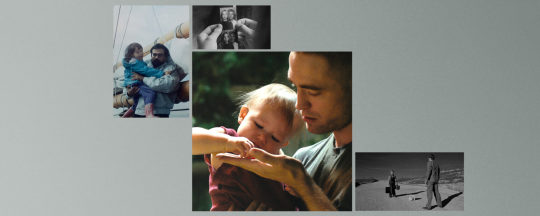
The way Wim Wenders tells it, it was his co-producer on the set of Paris, Texas who insisted she’d found her. The perfect assistant. A young woman who would, according to Wenders, guide him “safely through this journey into unknown territory.”
Thirty-six years later, and calling to mind Wenders’ West Texas desert—how it cites the pure vacancy of a lunar landscape—we enter real space. But not the sort of space one hurtles through, dutifully. And not the sort of space flecked with stars and dust, sanctifying some great, beautiful beyond. No. This space, as conceived by director Claire Denis—that young woman who once guided Wenders safely into unknown territory—is decelerated and grisly, spiraling yet carnal. It’s the filmmaker’s English-language debut, a difficult albeit awing movie cleverly titled High Life. In it, Denis administers somatic doom at nearly every turn, telling the story of Monte (Robert Pattinson), the sole survivor—along with his infant daughter, Willow—of a twisted, failed mission where the government has sent death row inmates into space to collect energy from a black hole.
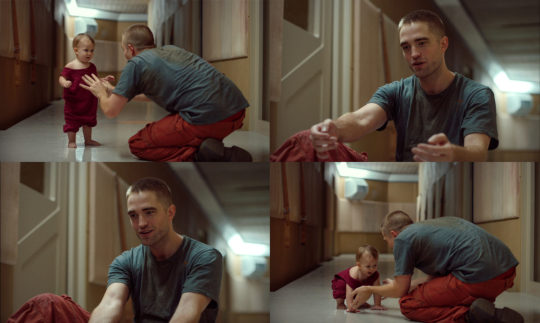
Monte and Willow’s life is incremental. Hermetic and isolated. One tiny step at a time, one lullaby, one sleep. Like the three notes of a familiar tune, reprising over and over, Monte and Willow’s life is eerie-anticipant. Somehow amateurish. They are the only ones.
What is it about fathers and daughters that feels predisposed to imagery of what’s left? Or of what’s been left behind. Of winging it while on the road. What is it about a father and daughter that so easily resembles two souls on the lam? Seeking and lost in a lovely way, but not free.
**
Paper Moon (1973) is a movie played by a real-life father and daughter. Ryan O’Neil and Tatum O’Neil are Moze and Addie, con artists during the Great Depression. Polly Platt’s unequaled production design and her material vision of Midwestern flatlands, windswept and wide open, give rise to an environment—much like space’s inhospitable wonder—that evokes the end of something or the very start. The film’s poster features father and daughter, sitting on a crescent moon, cold sober among the stars. Theirs is a high life, too.
The poster for High Life. Two hands, holding on. The tagline reads “Oblivion awaits.” Like some fugue-state invitation playing into that funny feeling which exists so long as the outcome isn’t fully known: anticipation. That the father-daughter pair are in space is clarified only through the father: his fingers are gloved in his space suit. Hers are pudgy. A baby’s wrist marked by how it doesn’t totally taper. A baby’s grip marked by its remarkable strength. We cannot help but remark on the baby’s grip. So strong, we’ll say.
While Moze and Addie are sitting on a crescent moon, as if the moon were a swing bench, Monte and baby Willow are holding hands among lush, medicinal-green growth. Little yellow mushrooms sprout. This zone is damp, misty, cared for. The sort of green not associated with space but with sativa. Green is High Life’s incongruous strange. It’s the film’s attempt at Arcadia, so long as Arcadia—in true Denis form—is portioned and untenable. Denis’ vision for High Life is both void and overgrown. This paradoxical, amazingly plotless torpor represents only a small portion of why High Lifedefies category. Of why High Life is near impossible to metabolize. Of why High Life’s use of green is matched only by its use of red and magenta (green’s opposites on the color wheel). The inmates’ uniforms are dyed a maroon-red. (André Benjamin plays Tcherny, an inmate who wears his uniform while nursing the garden.) The ship’s interiors radiate an oxidized red. (Juliette Binoche plays Dr. Dibs, a wanton doctor wearing a Renata Adler braid, who navigates those interiors, deliberately, lasciviously.) Red, in this case, represents what’s cosmic but also what’s bodily. Glowing, pulsing, planetary light. Blood, fluids, insides, throb. The red and magenta, and the green, recall Paris, Texas. Harry Dean Stanton as Travis Henderson, lost in the film’s opening, wearing his red baseball cap—a panorama of green mountains behind him. Nastassja Kinski’s Jane Henderson. Her bright pink sweater. That room with red accents like a phone, the lamp, the curtains. She’s separated by a pane of glass like Monte in space, in his red room, also separated by a pane of glass: his helmet, the shuttle.

**
Why does High Life feel like a Western? Its irreverence? Or maybe it’s all this talk of Wenders. Sam Shepard, who co-wrote Paris, Texas (finishing it over the phone), feels close to a Monte. That cowboy sensibility that neighbors monastic, that feels like poetry. Like Monte himself, who practices quiet, measured restraint. Who keeps to himself. Whose proximity to violence is indistinct.
In Denis’ Nénette and Boni (1997), Gregoire Colin, who plays Boni, also has shorn hair and sharp features. He is a brother caring for his estranged sister, Nénette, who re-enters his life seven months pregnant. As Roger Ebert wrote in his review, “They form, if you will, a couple. Not one based on incestuous feelings, but on mutual need and weakness: Boni provides what emotional hope Nénette lacks, and her pregnancy adds a focus and purpose to his own life.” Denis gives the family a feeling of fringe. Denis portrays family as an impression; as the people we can count on to interrupt our lives.
**
What is it about fathers and daughters, in film, that seems suited for the sky? That certain stupor that being up there delivers. There’s Armageddon, for one. Fly Away Home and Interstellar, too. Maren Ade’s Toni Erdmann was certainly, perfectly, out there. Monte is an outlaw. Moze is a conman. In one of High Life’s earliest lines, Monte is tending to Willow. He says, “Don’t drink your own piss, Willow. Don’t eat your own shit. Even if it’s recycled. Even if it doesn’t look like piss or shit anymore. It’s called a taboo. TAH-BOO. TAAAAA-boo.” The first word he teaches his daughter explains who he is, in part, or how Monte is categorized: someone, something, banned. And yet, the way Pattinson says TAAAAA-boo, seems to hint at what High Life raises and dismisses. The closeness between father and daughter. This isn’t a story of what gets passed down.
While Wim Wenders was preparing production for Alice in the Cities (1974), the first film in his road trilogy, a friend took him to see Paper Moon. Wenders—shaken by the film’s similarities to Alice (the black and white; the road; the searching men Philip and Moze; the girls, nine-years-old yet persuasive, tough equals)—nearly cancelled his film. Eventually, and thanks to the advice of Samuel Fuller, Wenders rewrote the script to differentiate it. His poetic, plainspoken script which brings to mind Platt’s dusty, terrestrial design for Paper Moon, is perfectly articulated by a line in Alice. Describing the view from a plane, as captured in a Polaroid—the plane’s wing, its shadow, the sky’s vast cozy of clouds—Alice says, “That’s a lovely picture. It’s so empty.”

**
In an essay by the writer Siri Hustvedt, titled “My Father Myself,” Hustvedt describes how as she got older, there was a shift in her relationship with her father. “He seemed unavailable to a degree that startled me,” she writes. “It could be difficult for him to say, so sometimes he would do.” Hustvedt recounts a tearful, painful visit to the orthodontist where she was fitted for braces. On the way home, her father stopped at a gas station, left the car, and returned with a box of chocolate-covered cherries — her father’s favorite. “I was eleven years old and, even then, I felt poignancy mingle with comedy.” She didn’t like chocolate-covered cherries and couldn’t possibly eat them having just been fitted for braces. “The mute gesture has stayed with me as one of infinite, if somewhat wrong-headed kindness, and as a token of his love.”
Monte calls Willow his “little package.” She was delivered to him; he carries her though he didn’t carry her. Monte is a reluctant father who studies his daughter’s approach to life, like some kind of loving, curious reconnaissance. The soothing doesn’t come naturally. There is no intense identification. He handles her undecidedly. Theirs is a solitude that feels both invented, but also, a means for recovery. Wordless gestures that seem to say, we’re in it together. The film’s last line—“Shall we?”—submits to this notion, as if answering High Life’s tagline. “Shall we?” is less of a question and more of a pact.
**
My father recently spent a month in the hospital, in isolation. One evening, I went to see him after work. I stayed with him for four, five hours, not saying anything while he slept. He was in agony—of which he tried to show little. But there it was—the pain—in how he slept, curled up and head covered by his blanket. He’d become thin. He wasn’t eating. There were tubes and beeping sounds, masks, and hospital gowns. I sat on a daybed near the window, my palms growing sweaty in latex gloves. It was dark and we felt deserted. Like the entire world outside my father’s hospital room no longer existed. Or if it did, once, it was now abandoned. That particular hush, like an aftermath, like the phone lines had been cut. That hush, like the science of a hospital room—engineered to monitor life, yet devoid of it, somehow. There was nothing to do but be the company and comfort my father’s subconscious needed. My mind wandered to a singsong Bengali refrain my father used to say to me before bed, when I was a kid. It went:
Akashey aakta chand, arekta chand koi?
(There is a moon in the sky, where is the other moon?)
And I would shout: Eiijey!
(Here I am!)
Sitting in the hospital, on the daybed just five or so feet from my father, I kept wanting to whisper, Eiijey! Eiijey, Baba!
In that dark room, we felt like two moons alone in the sky.
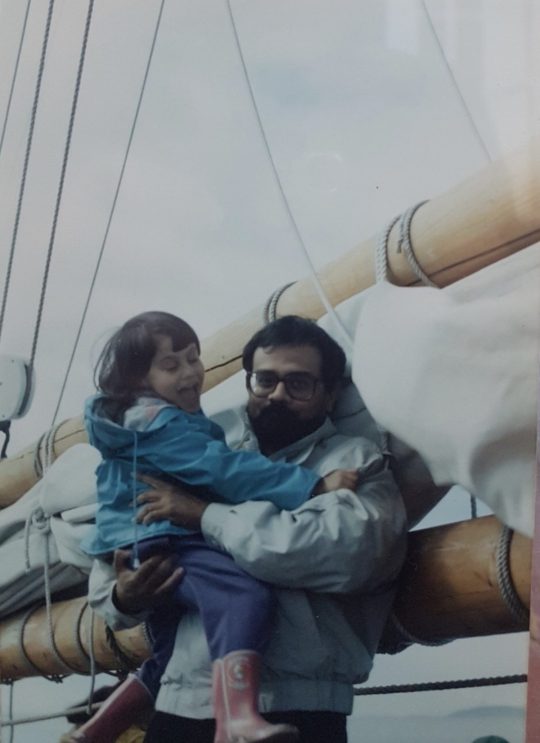
-Durga Chew-Bose
2 notes
·
View notes
Text
Rinsing recyclables
Many of us have wondered about rinsing recyclable containers before putting them in the bin. Does it take more energy than is saved by recycling? Is it necessary? I found a webpage that gives answers. The short answer is that a quick rinse to get the gooey food off is a good idea. This keeps vermin away from the recycled materials until they are processed and keeps the food from ruining co-mingled materials such as paper. There’s a link at the bottom of this post with a bit more information. Some things to remember about recycling:
You don’t need to get the bottles, cans, and jars completely clean, because they are washed at the recycling center.
A quick rinse is enough. Try putting a little water in the container and then swishing it around or using your hand to scrub the inside. That way you only use a little water.
We sometimes swish oily or greasy recyclables in the dirty dishwater at the end of a washing session, so no extra water or soap are used.
Don’t leave a lot of grease or food on the recyclable containers because it can contaminate other materials such as paper and prevent them from being recycled.
Check the recycling rules for your location to make sure you understand what can be accepted.
https://lifehacker.com/how-to-rinse-your-recyclables-without-wasting-water-1826764672
89 notes
·
View notes
Text
(since no one is reading my tags or other reblogs): this post has an addition. the addition is specifically about co-mingle recycling in most usamerican cities. always check your local guidelines for recycling. the point of this post was not to tell you what you can or can’t recycle, anyway. the point was that a lot of recycling gets thrown out because it’s fucking contaminated. if you can’t clean your recyclables to keep them from contaminating a whole bin, just put it in the trash. you don’t need to feel guilty about it... that's it. that's why i wrote the post.
#this is not a character judgement against him btw i'm just surprised#working at a landfill and recycling plant no matter how short a time will seriously turn you into the kind of person#who un-contaminates recycling bins#i'm in there digging plastic straws and bags and food-soiled containers out of the recycling#because otherwise the entire bin will be trashed
7K notes
·
View notes
Text

Elevate your recycling efforts with Richmond Waste's Co-mingled Recycling Service! Our convenient solution allows you to combine various recyclables in one bin, streamlining the process and maximizing efficiency.
0 notes